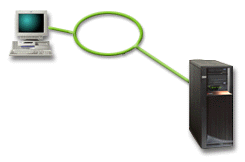Scenario: Consoles for multiple systems or partitions
This scenario discusses a situation in which you want to manage multiple systems or partitions.
Your company owns a System i™ product, and you want to use the PC to manage your system. You need to manage multiple systems or partitions from one console. You have a secured network that you can configure your console on.

For this scenario, configure a local console on a network.
Advantages:
- You can configure a single PC to be the console for several different systems or partitions as long as they are connected to the service connection network. There are a maximum of 26 active consoles at a time but you might have a virtually unlimited number of configurations.
- The administrator does not need to be physically near the system to manage the console.
- Security features are available to protect your console connections.
- A local console on a network is the connectivity of choice for partitions in an LPAR environment.
- Multiple PCs can be configured as a console to a system or partition, but only one PC can act as an active console at a time.
Disadvantages:
- No console is available in the event that a network failure takes place unless a backup console is available. Configure a local console directly attached to the server or a twinaxial console for backup.
- Your system will need a separate LAN card to be used by the console or other service tools.
Parent topic:
Scenarios: Selecting your configuration
Related concepts
PC preparations for Operations Console
Related reference
Operations Console hardware requirements
Planning considerations for your backup console
Related information
Plan for logical partitions